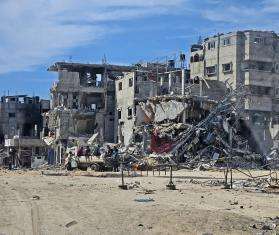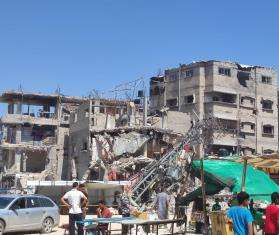Treatment to Prevent Blindness at an ?Impossible Price?
It is not uncommon for people living with advanced HIV/AIDS in Southeast Asia to go completely blind, mysteriously, and in a very short period of time. In fact, these irreversible cases of blindness are caused by Cytomegalovirus (CMV), a member of the herpes virus family, which leads to blindness in those with compromised immune systems.
Blindness caused by CMV is preventable, but the treatments are invasive and far from ideal—injections directly into the affected eye or intravenous, twice-daily treatment. A four-month supply of the best available treatment, valganciclovir—an oral medication produced by Hoffmann-La Roche—costs $10,000 and is simply too expensive for some of the people most at risk of going blind.
Dr. David Wilson, former MSF medical coordinator in Thailand, explains why access to affordable valganciclovir is so critical in low and middle-income countries where CMV poses a major threat.
When did you first see CMV in the field?
It was a long time ago, before antiretroviral (ARV) treatment was available in Thailand. It seemed to be fairly common among patients who were very sick at home. At the time, MSF gave palliative, compassionate care for people who were very sick with AIDS. Some of them went blind and then died.
How did this change when MSF started providing antiretroviral treatment in 2000?
I remember everyone was feeling really great that we were going to start treating people with antiretrovirals, with the hope of bringing people back to normal life. I remember the first patient that we ever started on treatment, in fact the first patient started on antiretrovirals by MSF anywhere in the world. But I remember her well for a very unfortunate reason—within one month of starting treatment she became blind from CMV. But since she was on antiretroviral treatment, her health improved, so she became strong and she lived for a long time, but the antiretroviral treatment doesn’t treat the CMV.
So patients—most of whom are young and of working age— get a second chance at life thanks to ARV treatment, but then can go blind because of the untreated CMV infection. Why does CMV-induced blindness have such a devastating impact on patients and their families?
The particular kind of blindness caused by CMV is absolute, total blindness. The patient cannot tell the difference between light and dark. They can see nothing. Someone who is blind from cataracts, for example, they can usually distinguish some things, they need some help, but often they can manage. But someone with CMV, when everything is totally, totally black it’s very difficult for them to eat without someone actually feeding them, for example, or to do very much of anything to help themselves. It’s a very, very severe kind of blindness.
How can CMV be treated in developing countries?
There are two possible medicines: one is ganciclovir and in Western countries this is given by intravenous injection, two times a day for three weeks followed by one time a day for three months. Alternatively, this same drug can be injected directly into the eye by a doctor with some experience with that technique. This only needs to be done once a week or once every two weeks, so is easier for the patient and is much cheaper. However, this only treats CMV in the eye, and CMV can cause other severe disease in other parts of the body. Better than that drug is a tablet which is chemically similar, called valganciclovir. It can be dispensed by a nurse or someone without expertise in giving injections. The patient can take the pills one time a day at home.
So there is better treatment, but it’s not in wide use, why?
There is effective treatment but it’s too expensive—$10,000 for a four-month course of treatment. It’s a monopoly product from a big pharmaceutical company, Hoffman-La Roche. In terms of diagnosis, we have a strategy to make the diagnosis; it does involve training people, getting experienced people to make a diagnosis. That’s feasible and that’s manageable but then once we have the diagnosis, we need the treatment and the problem is the treatment is at an impossible price.
What is MSF calling for?
We need Roche to lower the price and make it affordable. We’re asking Roche to reduce their price to $500 for a four-month treatment. Roche has offered a price of $1,899 for least developed countries. Thailand and China, considered middle income countries by the World Bank, are not eligible for this discounted price.
I’ve been working in MSF projects and treating people with AIDS with antiretrovirals for seven years now and along with many colleagues we’ve been frustrated because we don’t have treatment for this particular disease. We now think we have a strategy to diagnose it effectively and what we really need is the medicine to treat the patients.


